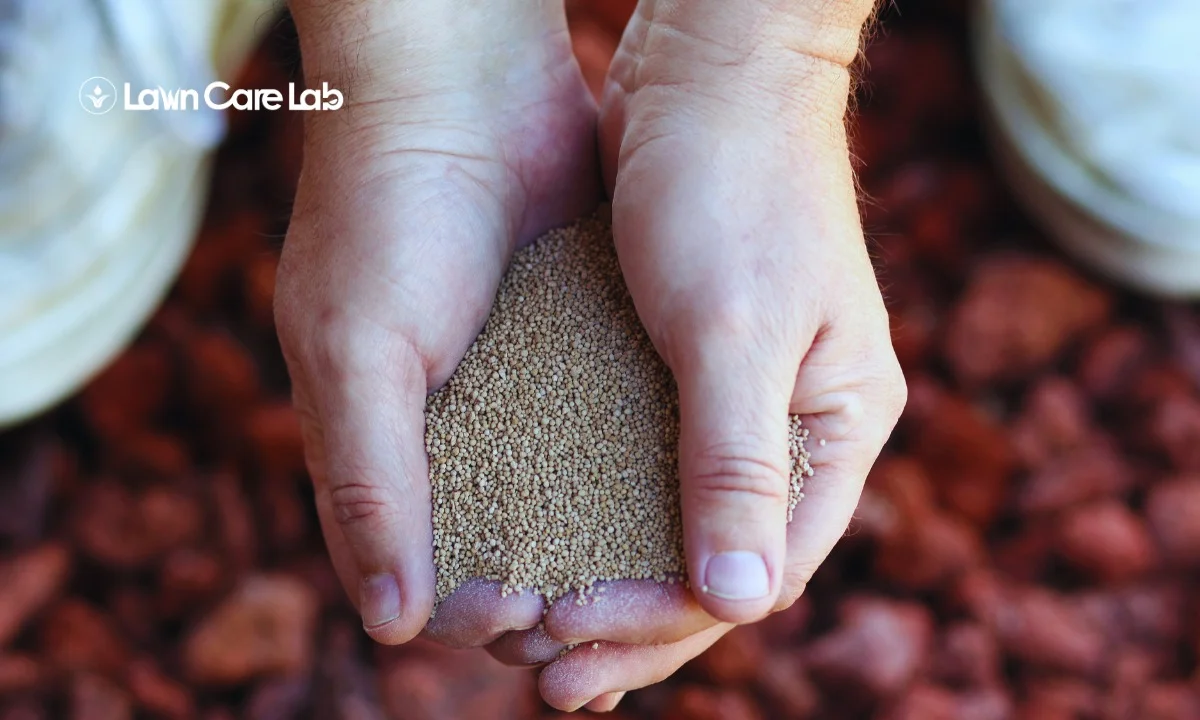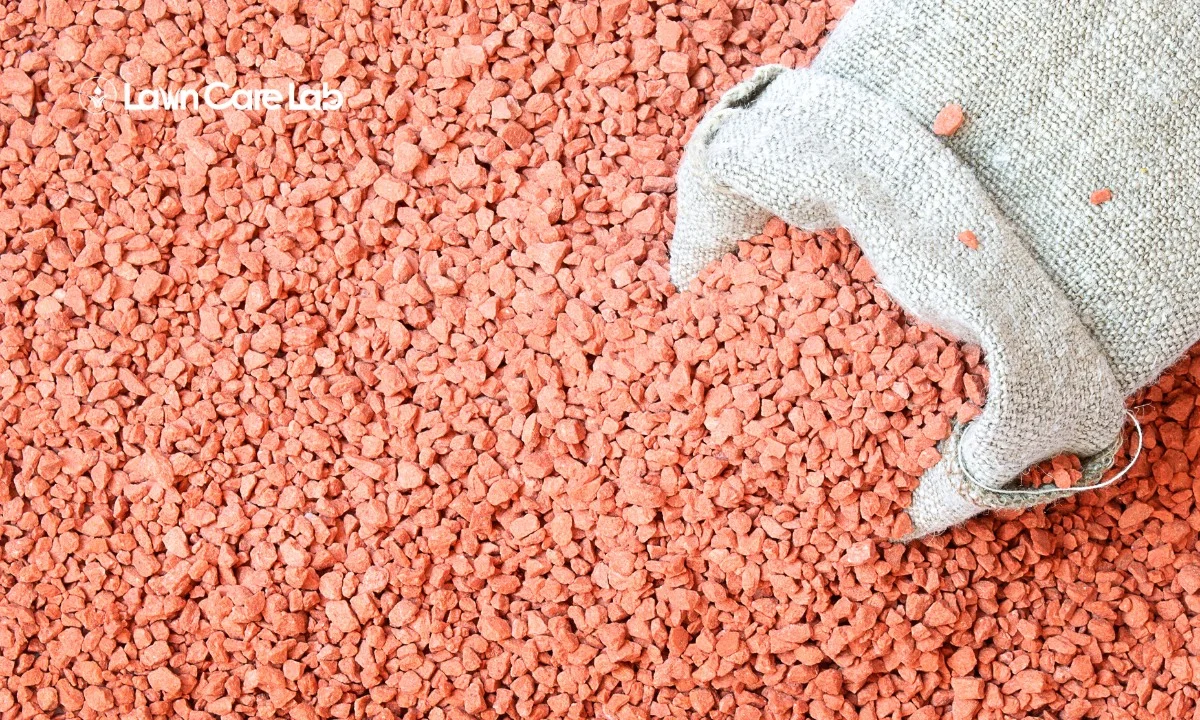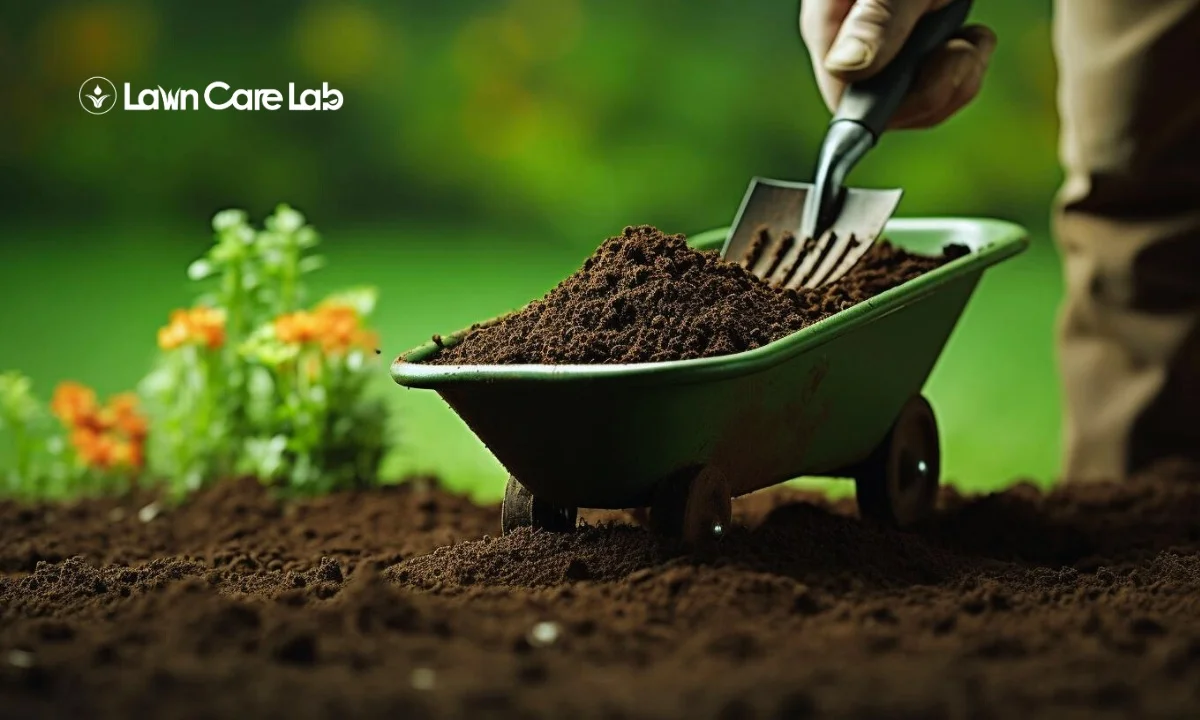Are you providing your lawn with the care it needs? An often overlooked aspect of lawn maintenance is the use of lime. Applying lime can profoundly affect your lawn’s health, impacting its pH balance and overall vigor.
It’s time to leave the shadows of uncertainty and familiarize yourself with the when and why of applying lime. We’ll also guide you in selecting the most suitable type of lime for your grass.
So, let’s journey into the realm of lawn lime and enrich your lawn care regimen.
Table of Contents
Liming Lawn Care Basics
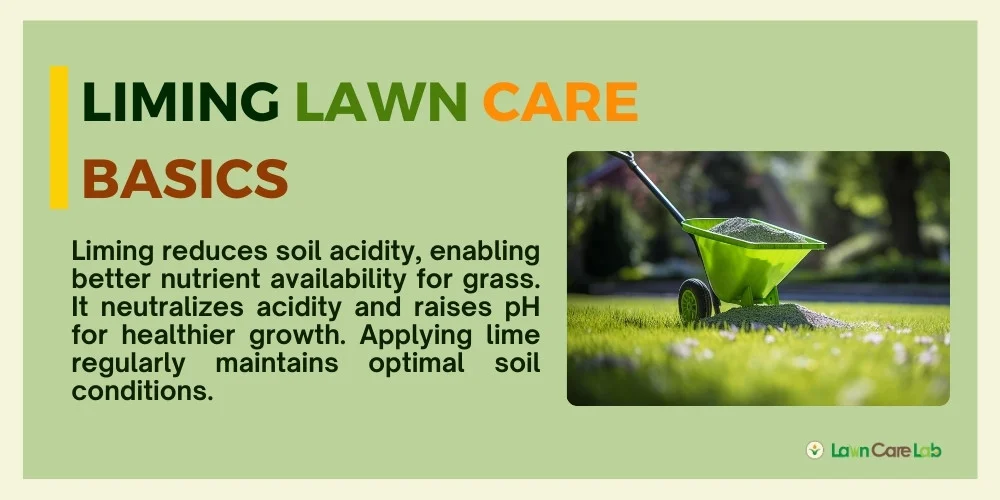
Liming is an essential aspect of lawn care that is often overlooked. It involves applying lime to the soil to reduce soil acidity, which can restrict the availability of nutrients.
By neutralizing the acidity and increasing the soil’s pH level, lime ensures that essential nutrients are easily accessible for your grass to consume.
This method promotes a healthier and greener lawn.
When to Lime Your Lawn
Start with a soil pH test to determine when to apply lime to your lawn. If your lawn requires liming, it’s recommended to do this every 1-2 years to maintain pH balance and counteract acid accumulation.
There are optimal periods for liming your lawn:
- Spring liming: This practice promotes root growth before the onset of summer heat, helping your lawn flourish.
- Fall liming: This readies the soil for winter and subsequent spring growth, encouraging a robust start once winter subsides.
- Liming new lawns: Apply lime a few weeks before planting a new lawn.
As an astute gardener, always prioritize safety. Timing your liming lawn right will maximize its benefits and help foster a verdant, thriving lawn.
The Importance of Proper Lawn pH
Maintaining the right lawn pH is crucial for efficient nutrient absorption, making grass resilient against pests and diseases.
By ensuring these levels remain balanced, you’re arming your lawn with the tools it needs to flourish in terms of health and vigor.
Enables Nutrient Uptake
Lime can be used to adjust the pH balance to prevent a nutrient lockout. This process – known as liming – benefits your lawn in several significant ways:
- It heightens nutrient availability, allowing your grass to absorb the vital nutrients it needs to flourish.
- It protects your lawn from nutritional deficiencies that can inhibit growth.
- It bolsters the health and visual appeal of your lawn.
Apply lime correctly and wear protective clothing to avoid skin irritation.
Strengthens Grass Against Pests/Diseases
Liming can neutralize excess acidity in lawn soil, which makes essential nutrients available to the grassroots.
By raising the pH levels to 6-6.5, liming enables grass to access nutrients like nitrogen, calcium, and iron/manganese, which are necessary for its growth, strength, and disease resistance.
Balancing the pH through liming strengthens grass, making it more resistant to pests and diseases while unlocking the nutrients it needs to thrive in your lawn environment.
How Lime Improves pH
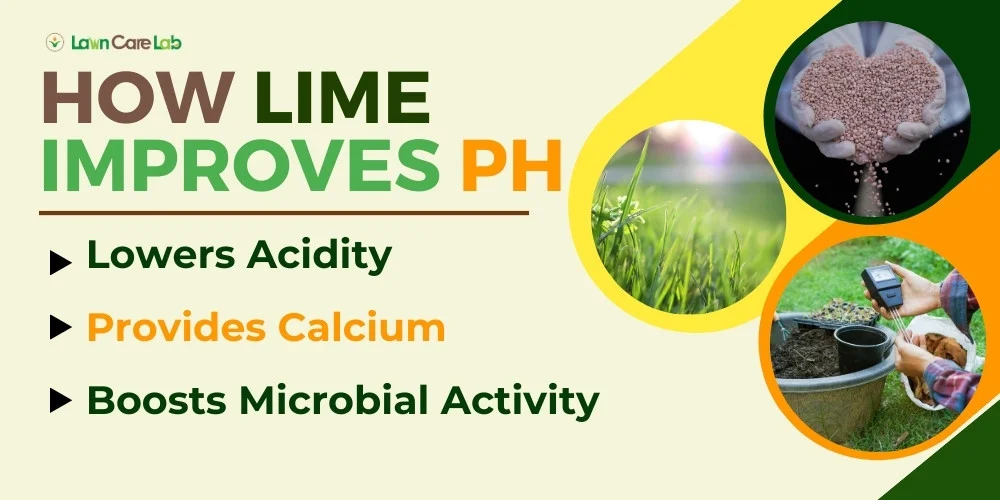
The influence of lime on the pH levels of your lawn may pique your interest.
Essentially, lime acts as a pH balancer, reducing soil acidity and making the lawn more hospitable for grass growth.
Moreover, it acts as a source of vital calcium and stimulates the activity of helpful microorganisms, thereby promoting overall lawn health.
Lowers Acidity
Lime, a compound made of calcium carbonate, can improve your lawn’s soil pH and reduce acidity.
This chemical reaction, fundamental for a thriving green lawn, works like this:
- Lime interacts with the acidic components in the soil, lessening their concentration.
- This interaction escalates the soil’s pH level, bringing it nearer to neutrality.
- A neutral pH facilitates superior nutrient uptake, which is key to a lush, healthy lawn.
Lime application improves your lawn’s health. Consider it a long-term investment for vibrancy and to stay safe from lawn blunders.
Provides Calcium
Lime application neutralizes soil acidity and infuses the soil with calcium, a key nutrient that encourages healthy grass growth. Calcium strengthens grass cells, making them more rigid and resilient.
It also helps maintain an optimal pH level, promoting efficient nutrient absorption and a vibrant lawn.
Boosts Microbial Activity
Lime creates ideal conditions for microorganisms that are vital to lawn health. It balances pH, which benefits microbes sensitive to acidity. Lime also provides calcium to spur microbial growth.
By facilitating the decomposition of organic matter, it allows microbes to release nutrients that grass can utilize.
Overall, lime supports a thriving microbial ecosystem below the surface, caring for the invisible foundation of a healthy, flourishing lawn.
Choosing the Right Lime
Choosing the right lime for your lawn requires understanding the available options and their effects. Proper lime application rates are carefully calculated to ensure grass benefits without harm.
Be sure to consider this sage advice when choosing lime for your lawn.
Types of Liming Materials
Two primary types of liming materials exist:
- Calcitic lime is primarily beneficial for infusing calcium into your soil. This makes it an excellent choice if your lawn only suffers from a calcium deficiency.
- Dolomitic lime is invaluable for supplementing both calcium and magnesium. This variant is most suitable for lawns that are lacking in both of these nutrients.
Soil testing is essential before choosing a lime for your lawn. It helps identify the nutrients your lawn needs. Safety is crucial when handling lime, which can cause skin irritation. Follow the application instructions for a safe and healthy lawn.
Calculating Application Rates
For a healthy lawn, apply lime correctly. Factors to consider are soil composition and pH levels. A soil test helps determine the required amount by revealing the soil’s pH and type.
| Soil Composition | Lime Quantity per 1000 sq. ft (in lbs) |
|---|---|
| Sandy | 25-50 |
| Loam | 75-100 |
| Clay | 100-150 |
| Peaty | 150-200 |
Soil test is necessary to determine the amount of lime required for a healthy lawn. Proper selection and application of lime is essential.
Applying Lime for Maximum Impact

Lime improves lawn health, but technique matters. For large areas, use a spreader and follow instructions. Water thoroughly after to raise the pH. Careful application ensures maximum benefits.
Broadcasting by Hand
Breaking up sections while spreading by hand prevents any missed spots. Wearing protective gear is advised to avoid any irritation. It is best to spread on calm days for optimal results.
The secret to fruitful lime application lies in uniform coverage. Armed with a thoughtful strategy and a commitment to safety, you can optimize your lawn’s health and vitality with this hands-on technique.
Using a Spreader
A spreader helps distribute lime evenly across your lawn. After loading the spreader, walk it over your lawn with the release mechanism engaged to disperse the lime.
Follow the manufacturer’s guidelines for spreader settings. Apply on a calm day to prevent uneven spreading from the wind. Wear protective gear for safety.
Once applied, water the lawn to help the lime infiltrate the soil. Even spreading and watering are key for the lime to improve lawn health effectively.
Watering After Application
In the post-application phase of liming your lawn, giving it good watering is of utmost significance for the best results. The hydration process acts as a catalyst, helping the lime penetrate the soil efficiently and start its beneficial work.
Here are some practical and safety-oriented tips to keep in mind:
- Gently drench your lawn. An overzealous watering approach may wash off the lime before it can act.
- Refrain from watering at the day’s peak when the sun is at its zenith and evaporation rates skyrocket. Opt for the early morning or the dusk hours.
- Ensure an even watering session across your lawn without limiting it to the lime-applied areas.
The Impact of Liming on Different Grass Types
Lime’s influence on grass isn’t a one-size-fits-all scenario. Different grass species respond distinctly to lime application, whether they thrive in cool seasons or warmer climates.
Here, we’ll clarify how to fine-tune your liming strategy based on your lawn’s specific grass type.
Cool Season Grasses
For those nurturing cool-season grasses such as fescue and ryegrass, it’s important to note that these species thrive in slightly acidic soil. Excess lime can damage grasses by hindering nutrient absorption. Moderation is key.
Here’s how to ensure a healthy, vibrant lawn:
- Keep a close watch on soil pH: Regularly checking the soil’s pH level with a reliable meter can provide you with precise data, facilitating appropriate adjustments to lime usage.
- Maintain a consistent liming schedule: Too much lime can harm cool-season grasses. A good schedule can help manage lime effectively.
- Practice sensible lime usage: Apply only the amount needed to strike a balance, steering clear of overuse that could harm your lawn’s health.
Warm Season Grasses
As summer approaches, it’s important to focus on warm-season grasses like Bermuda and St. Augustine. These grasses thrive in alkaline soil with a pH range of 6.5-7.0. Applying lime at the right time can significantly improve their health and vitality.
To help you understand better, here’s a simple yet informative table:
| Grass Type | Preferred pH | Requirement for Liming |
|---|---|---|
| Bermuda | 6.5-7.0 | High |
| St. Augustine | 5.0-7.0 | High |
| Zoysia | 6.0-7.0 | Medium |
| Centipede | 5.0-6.0 | Low |
| Carpet | 6.0-7.0 | Medium |
Making Liming a Vital Part of Your Lawn Care
Integrating lime into your lawn care regimen effectively sustains optimal soil pH levels, promoting healthier and more thriving grass. The regular use of lime in lawn care offers enduring advantages.
- Timing is Key: Adding lime in spring and autumn keeps soil pH optimal for your grass.
- Promoting Soil Well-being: Regular lime application improves soil quality, aiding grass growth.
- Optimizing Nutrient Absorption: The right pH balance allows your grass to take full advantage of seeds, fertilizer, and water, increasing their efficacy.
Safety should never be compromised. Adhere to product guidelines and wear suitable protective attire when handling lime. Incorporate liming into your lawn care regimen to enjoy a lush and attractive yard.
- How to Create a Lawn Care Schedule for Southern Climates - October 30, 2024
- How to Use Compost Tea to Boost Lawn Growth and Soil Health - October 23, 2024
- The Best Grasses for Saltwater-Exposed Lawns: Coastal Lawn Care - October 17, 2024

